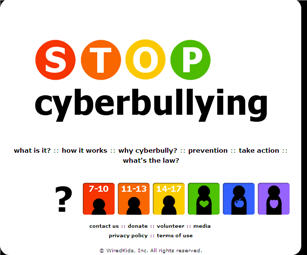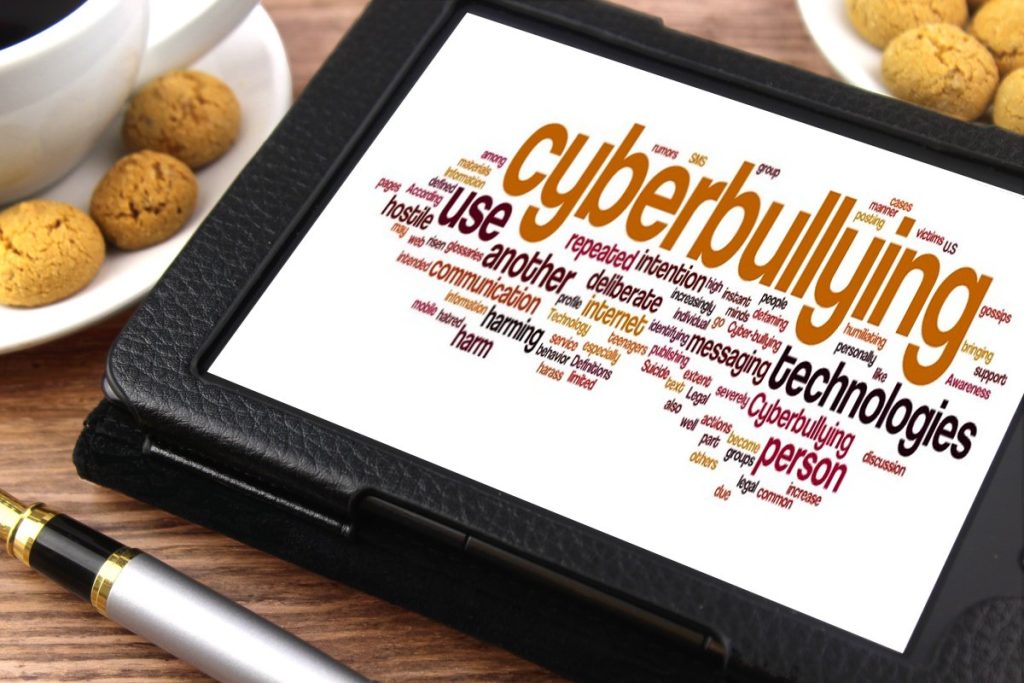
“Cyber-bullying” by Iyadwaleed is licensed under CC BY-SA 4.0.
In the current epoch, distinguished by significant technological advancements and universal embracement of digital mediums, a covert, deleterious form of harassment—cyberbullying—has burgeoned, embedding itself as a ubiquitous component of online discourse. Cyberbullying is defined as the intentional utilization of digital platforms to disseminate false, embarrassing, or aggressive information about another individual, predominantly among adolescents (Smith et al., 2008). This contemporaneous variant of bullying is exceptionally malicious due to its capability to afflict victims irrespective of their geographical location, surpassing the spatial confines inherent to its traditional counterpart.
The rapid ascendancy of cyberbullying is integrally associated with the exponential growth of social media and digital platforms—arenas which provide fertile substrates for the manifestation of destructive behaviors owing to their omnipresence and accessibility. Indeed, contemporaneous research highlights that a considerable fraction of the youth population has been a victim of cyberbullying at some point, emphasizing its ubiquity in today’s digital ecosystem (Patchin & Hinduja, 2016). The ceaseless advancement and amalgamation of technology have dramatically amplified both the prevalence and ramifications of cyberbullying, with individuals allocating more time to the virtual world, and concomitantly becoming vulnerable to the perils of malicious online endeavors.
Parallel to the technological metamorphosis, the intricacies and nuances of cyberbullying have escalated, often unfolding imperceptibly, beyond the immediate perception of guardians or educators. This necessitates an in-depth comprehension and concerted approach to alleviate its enduring, adverse repercussions on individuals and the societal fabric. In this essay, an exhaustive investigation of the clandestine menace of cyberbullying is embarked upon, examining its multifarious forms, repercussions, and prospective countermeasures, aiming to cultivate a more secure and inclusive digital milieu.
The Forms of Cyberbullying
Cyberbullying, a hazardous offshoot of our modern, digitized era, manifests in a myriad of variants, each illustrating the malevolent manners in which technology can be manipulated to inflict damage upon individuals. One prevalent technique is harassment, characterized by the relentless and intentional dissemination of harmful comments or messages, predominantly observed on platforms of social media. A study conducted by Smith et al. (2008) unveiled that 23% of adolescents have encountered such harassments, resulting in substantial psychological ramifications. This statistic accentuates the urgency to scrutinize the societal and psychological structures that enable such pernicious activities and to devise strategies to mitigate their impacts.
Flaming, a subsequent variant, is defined by the enactment of disseminating incendiary comments with the intent to evoke and escalate emotions. These instances are frequent in online forums and typically incite vehement and derogatory dialogues. This demonstrates the detrimental potential of unregulated discourse and underscores the necessity for efficacious moderating systems to maintain decorum and counteract hostility within digital spaces.
Doxxing, the unauthorized revelation of private information, constitutes another virulent form, where the private details of the victims are disclosed online without their acquiescence, leaving them susceptible to intensified abuse and identity theft. This presents grave repercussions; victims have endured severe circumstances as their personal addresses and contact information were distributed with malicious intent. It brings forth critical reflections on privacy and security in the cyber realm, emphasizing the imperative to bolster digital defenses and enact stringent legal frameworks to protect individuals’ sensitive information.
Impersonation is another covert and prevalent strategy wherein perpetrators fabricate fraudulent profiles with the intent to deceive and tarnish the reputations of their victims, occasionally causing irreversible reputational damage. This underscores the immense power and influence that virtual identities hold in contemporary society and accentuates the need for robust verification mechanisms to ensure the authenticity and integrity of online personas.
Lastly, cyberstalking, a practice where offenders relentlessly observe and intimidate victims online, breeds an environment of fear and anguish. This highlights the pervasive and invasive nature of such malevolent behaviors in the online sphere, calling attention to the ethical implications of online interactions and the importance of establishing stringent, equitable, and enforceable norms and policies to safeguard the well-being of internet users.
These manifestations of cyberbullying illuminate the intricate and multifaceted challenges posed by the intersection of human interaction and digital technology. It necessitates a holistic and multidisciplinary approach to understand the underlying mechanisms, develop preventative measures, and ensure the ethical and responsible use of technology. The evolution of cyberbullying reinforces the cruciality of ongoing research, dialogue, and intervention to address the detrimental impacts and ethical considerations inherent in the digitized landscape of human communication.
The Implications of Cyberbullying
Victims of cyberbulling often encounter a plethora of mental health afflictions, such as depression, anxiety, and diminished self-worth. The incessant nature of virtual harassment, facilitated by the omnipresence of the internet, ensures the continuity of such torment, incessantly undermining the mental fortitude of the afflicted individuals.
Such relentless oppression can thrust victims into profound despair, leading, in extreme instances, to manifestations of self-infliction and, lamentably, suicidal ideation (Hinduja & Patchin, 2010). The psychological scarification and the sustained states of trepidation and distress, characteristic of cyberbullying, often remain latent, progressively undermining the mental resilience of the victims. The residue of such traumatic experiences can linger indefinitely, compromising victims’ perceptions and inhibiting the cultivation of constructive, affirmative relationships in both virtual and physical realms.
Cyberbullying induces detrimental consequences not solely upon individual victims but also corrupts relational dynamics and overarching ambiances within both digital communities and physical spaces. The strain and dissolution of trust and social bonds provoke isolation and withdrawal amongst victims (Kowalski et al., 2014). Observing loved ones succumb to such psychological torment often renders friends and family feeling incapacitated and distressed, trapped in a state of helplessness, unable to ameliorate the suffering endured by their loved ones.
Additionally, the prevalence of cyberbullying engenders a hostile and deleterious culture within communities. Such malignancy permeates virtual environments, engendering a landscape plagued by hostility, fear, and suspicion. This environment often becomes a breeding ground for negativity, thereby perpetuating a cycle of aggression and malevolent conduct. The toxic milieu propagates and compromises the integrity of the community, undermining societal unity and generating a climate of enduring tension and animosity (Van Geel et al., 2014).
Preventative Measures and Solutions

“stop cyberbullying” by FunnyBiz is licensed under CC BY-SA 2.0.
Addressing the ubiquitous yet concealed menace of cyberbullying requires rigorous preventative measures and meticulously conceived solutions to diminish the perils intrinsic to the digital realm. One paramount remedy is the emphasis on nurturing digital literacy and etiquette, a fundamental element in engendering prudent online conduct. Disseminating education on online safety, judicious utilization of social media, and the severe repercussions of cyberbullying can enhance individual capacity to traverse digital domains with assurance and courtesy. When synthesizing critical reflection on these matters, it becomes apparent that fostering an environment where digital literacy is paramount can significantly alleviate the occurrence of cyberbullying by inculcating a sense of responsibility and accountability among netizens.
Effectively counteracting cyberbullying necessitates the enforcement of rigorous policies within online platforms. The integration of potent moderation, unambiguous community norms, and expedited reporting infrastructures can curb malevolent online activities (O’Keeffe, Clarke-Pearson, & Council on Communications and Media, 2011). It is critical to contemplate the essential role these policies play, serving as protective barricades for users, fostering harmonious online engagements, and enhancing overall user experience. The synthesis of such policies is imperative to maintain a balance between freedom of expression and the preservation of user safety and dignity.
Moreover, instruments of parental control are pivotal in regulating and scrutinizing online dialogues. These utilities aid in obfuscating unsuitable content and supervising digital interactions, thus contributing to the early identification and thwarting of cyberbullying (Livingstone, Haddon, Görzig, & Ólafsson, 2011). The amalgamation of active parental participation in children’s online pursuits, along with the utilization of monitoring tools, ensures the cultivation of a protective ambiance for juvenile users. It is crucial to critically assess the impact and effectiveness of such instruments in safeguarding younger demographics from the clandestine hazards lurking in the digital sphere.
Educational entities are entrusted with the formidable task of nurturing a resilient and secure cyber environment. The incorporation of cyber ethics and online safety within educational syllabi is crucial, as it imparts the virtues of respect and responsibility (Willard, 2007). Facilitating access to resources and ongoing enlightenment on the subject of cyberbullying is pivotal to equip students with the requisite acumen to identify, report, and neutralize deleterious online conduct. A comprehensive and reflective understanding of the aforementioned strategies is indispensable in fostering a resilient and informed student body capable of navigating the intricacies of the digital landscape.

Cyberbullying by Nick Youngson is licensed under CC BY-SA 3.0.
In conclusion, the identification and neutralization of cyberbullying embody a collective obligation. The convergence of enhanced digital literacy, stringent platform regulations, parental monitoring, and pedagogical strategies cohesively contributes to the cultivation of a more secure digital environment. It is absolutely imperative that each individual endeavors proactively to construct secure and respectful online realms, thereby fostering a digital culture imbued with respect and empathy and counteracting the stealthy peril of cyberbullying.
References List
Hinduja, S., & Patchin, J. W. (2010). Bullying, cyberbullying, and suicide. Archives of suicide research : official journal of the International Academy for Suicide Research, 14(3), 206–221. https://doi.org/10.1080/13811118.2010.494133
Kowalski, R. M., Giumetti, G. W., Schroeder, A. N., & Lattanner, M. R. (2014). Bullying in the digital age: A critical review and meta-analysis of cyberbullying research among youth. Psychological Bulletin, 140(4), 1073–1137. https://doi.org/10.1037/a0035618
Livingstone, S., Haddon, L., Görzig, A., & Ólafsson, K. (2011). Risks and safety on the internet: the perspective of European children: full findings and policy implications from the EU Kids Online survey of 9-16 year olds and their parents in 25 countries. https://eprints.lse.ac.uk/33731/1/Risks%20and%20safety%20on%20the%20internet(lsero).pdf
O’Keeffe, G. S., & Clarke-Pearson, K. (2011). The impact of social media on children, adolescents, and families. Pediatrics, 127(4), 800-804.
Patchin, J.W., & Hinduja, S. (Eds.). (2011). Cyberbullying Prevention and Response: Expert Perspectives (1st ed.). Routledge. https://doi.org/10.4324/9780203818312
Smith, P. K., Mahdavi, J., Carvalho, M., Fisher, S., Russell, S., & Tippett, N. (2008). Cyberbullying: Its nature and impact in secondary school pupils. Journal of child psychology and psychiatry, 49(4), 376-385.
Van Geel, M., Vedder, P., & Tanilon, J. (2014). Relationship between peer victimization, cyberbullying, and suicide in children and adolescents: a meta-analysis. JAMA pediatrics, 168(5), 435-442.
Willard, N. E. (2007). Cyber-safe kids, cyber-savvy teens: Helping young people learn to use the Internet safely and responsibly. Jossey-Bass.



Be the first to comment on "The Silent Threat of Cyberbullying: Understanding its Dangers"